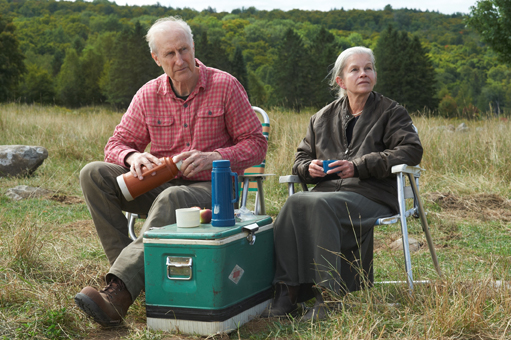Still Mine is a lovely tribute to traditional family values and home building. Though the outline of the irascibly stubborn old farmer up against rigid bureaucracy is familiar, James Cromwell gives his character considerable gravitas, in what is billed as the noted actor’s first starring role. (His farmer role in the two Babes was considered supporting the movies’ CGI.)
The septuagenarian Cromwell is more than a decade younger than the real-life 87-year-old Craig Morrison of New Brunswick, Canada, whom the film is based on. The opening shots zoom in on every wrinkle on Craig’s grizzled face as he prepares to face a judge to present his case: the town’s restrictions on his dream house are an assault on his way of life.
The story line then goes back two years in a long life with seven kids and a marriage of more than six decades to Irene (Geneviève Bujold, with no make-up and long gray hair). Craig gradually faces up to the changes around him. He still cares for the chickens, chops wood, and is handy with repairs in his carpentry workshop, but his grandson doesn’t appreciate his story of how he got Lou Gehrig’s and Babe Ruth’s autographs on a treasured baseball. He has to give over his dairy cows to his daughter Ruth (Julie Stewart), and his usual wholesaler rejects his homegrown berries as not up to new standards. But far worse, his beloved wife, who can still turn those surplus strawberries into jam, starts to dangerously forget things, and the stairs in their old house are becoming a threat to her safety.
This is usually the point in movies, like Tamara Jenkins’ The Savages (2007), where an elderly parent has to accept moving into assisted living of some kind (or escaping/getting kicked out, like Alan Arkin in a couple of recent movies). But Craig has a more independent idea for the future that will make use of his skills and experience: he plans to build from scratch a one-story, wheelchair accessible house to take advantage of the beautiful view (built on the producer’s property) on the dozen plus acres he owns. He also intends to cut down the pine trees on his land and turn them into lumber at the sawmill of his son, John (Rick Roberts), despite John’s disapproval and discouragement and the teasing from his crotchety oldest frenemy, Chester (George R. Robertson).
Westerns often feature a community barn-raising (and writer/director Michael McGowan’s 2010 Score: A Hockey Musical was very much about teamwork), but this northeastern is a one-man show (the bracing does take some trial and error), with the added time pressure of his promise to his wife to settle them in as she ails. (Bujold is feistier, and much less physically ill, than the comparable Parisian in Amour.)
So far this recalls the determined, idiosyncratic Silver Fox in David Lynch’s The Straight Story (1999), also inspired by a true story, but then Craig hits a bump in his road: building requirements that will touch a chord with those against government overregulation and those for artisanal craftsmanship (or both). Since unscrupulous contractors throw up flimsy construction, it’s understandable that uniform building codes have been adopted for safety, but the system doesn’t know what to do with an idiosyncratic, do-it-yourselfer—and Craig doesn’t know what to do with the new rules that are inflexible.
Up against an aggravated petty bureaucrat (Jonathan Potts), he reluctantly brings in his longtime lawyer (Campbell Scott), and he gets volunteer help from his engineer grandson (Zachary Bennett). Both convince him to bend a bit. (In an almost all-Canadian production, it feels odd that the most prominent pop song used over montages is by the British band Mumford & Sons.) When his construction is halted, time keeps urgently passing, putting a stress on all his relationships and adding suspense to the poignancy that is somewhat predictable but still tenderly moving and dignified.







Leave A Comment